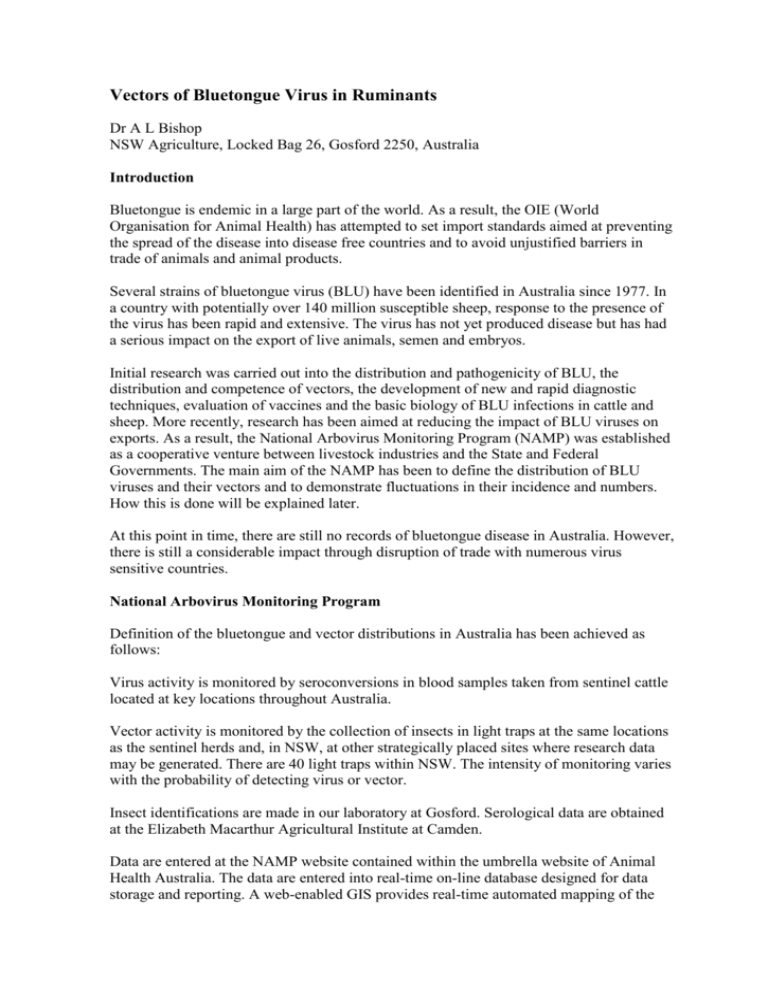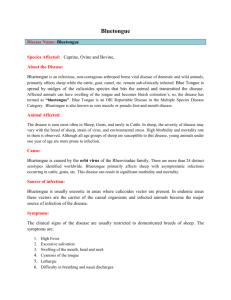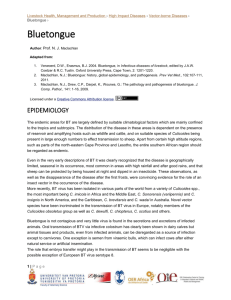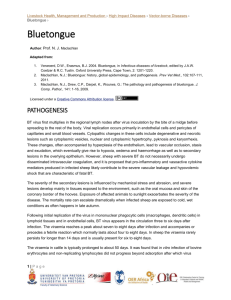Vectors of Bluetongue Virus in Ruminants
advertisement

Vectors of Bluetongue Virus in Ruminants Dr A L Bishop NSW Agriculture, Locked Bag 26, Gosford 2250, Australia Introduction Bluetongue is endemic in a large part of the world. As a result, the OIE (World Organisation for Animal Health) has attempted to set import standards aimed at preventing the spread of the disease into disease free countries and to avoid unjustified barriers in trade of animals and animal products. Several strains of bluetongue virus (BLU) have been identified in Australia since 1977. In a country with potentially over 140 million susceptible sheep, response to the presence of the virus has been rapid and extensive. The virus has not yet produced disease but has had a serious impact on the export of live animals, semen and embryos. Initial research was carried out into the distribution and pathogenicity of BLU, the distribution and competence of vectors, the development of new and rapid diagnostic techniques, evaluation of vaccines and the basic biology of BLU infections in cattle and sheep. More recently, research has been aimed at reducing the impact of BLU viruses on exports. As a result, the National Arbovirus Monitoring Program (NAMP) was established as a cooperative venture between livestock industries and the State and Federal Governments. The main aim of the NAMP has been to define the distribution of BLU viruses and their vectors and to demonstrate fluctuations in their incidence and numbers. How this is done will be explained later. At this point in time, there are still no records of bluetongue disease in Australia. However, there is still a considerable impact through disruption of trade with numerous virus sensitive countries. National Arbovirus Monitoring Program Definition of the bluetongue and vector distributions in Australia has been achieved as follows: Virus activity is monitored by seroconversions in blood samples taken from sentinel cattle located at key locations throughout Australia. Vector activity is monitored by the collection of insects in light traps at the same locations as the sentinel herds and, in NSW, at other strategically placed sites where research data may be generated. There are 40 light traps within NSW. The intensity of monitoring varies with the probability of detecting virus or vector. Insect identifications are made in our laboratory at Gosford. Serological data are obtained at the Elizabeth Macarthur Agricultural Institute at Camden. Data are entered at the NAMP website contained within the umbrella website of Animal Health Australia. The data are entered into real-time on-line database designed for data storage and reporting. A web-enabled GIS provides real-time automated mapping of the monitoring data and allows users to view up to the minute sentinel herd and vector trapping data. As a result three zones are defined – a free zone, a surveillance (buffer) zone (50-100k wide) and a zone of possible transmission. The system provides a high degree of confidence as well as providing a strong scientific basis to negotiation of health protocols to support trade. Vectors The major vector of bluetongue virus in Australia is a biting midge, Culicoides brevitaris. C.actoni and C.fulvus are also vectors but are restricted in their distribution to the far north. A fourth vector, C.wadai has extended its distribution to the east coast and can be found as far south as northern coastal New South Wales. All vectors are contained within the dispersive limits of C.brevitarsis. At the recent (26-29 October 2003) OIE International Symposium on Bluetongue, bluetongue disease was described as only a problem of Temperate climatic zones. Parts of New South Wales (NSW) fall within this zone and the known southern limits of the vectors and viruses exist within this state. I will concentrate on research conducted within NSW as this is where my research is carried out. Culicoides brevitarsis at the southern limits of its distribution Culicoides brevitarsis is the only vector of consequence in NSW. Its behaviour is closely aligned with the presence of cattle and it breeds in discrete pats of bovine dung. It exhibits crepuscular activity, resting by day, forming mating swarms just before sunset and feeding on cattle after sunset and before dawn. Its activity is closely governed by temperature and its activity starts to decline once maximum temperatures are below 17°C. Several scientific papers have been written describing the activity and biology of C.brevitarsis and these are provided. However, for this talk I would like to concentrate on three recently achieved research results: 1. Factors affecting the spread of C.brevitarsis at the southern limits of its distribution in eastern Australia. The southern limits of the bluetongue vector brevitarsis in eastern Australia are found in NSW. The vector is endemic on the northern/mid-northern coastal plain. It moves south in summer, but normally retains a coastal distribution. These movements have been modelled statistically and have been shown to depend on temperature, wind speed, wind direction, and the distance to be travelled from the endemic area. The vector moves at different rates in different areas and it was thought that slower rates of dispersal were related to geographical features, such as large urban areas to the south and the altitude/escarpment of the Great Dividing Range to the west. The Range would act as a physical barrier slowing movements to the western slopes and plains where there are high concentrations of susceptible sheep or cattle. An eight-year study was made of C.brevitarsis movements from the endemic coastal plains, and up coastal valleys of mid-northern NSW to the top of the Range. Models were developed to show that dispersal can occur on more than one occasion, and can be explained by the distance to be travelled, and the altitude of sites of destination. Altitude was found to delay movement by about 5 weeks for the first and 11 weeks for the second time that the vector reached the top of the Range at approximately 1000 m of altitude. Southern and western movements can therefore be predicted from a series of models. Periods of possible activity at sites of destination, and the probability of survival through winter at each new site, can be estimated from temperature data. Activity, subsequent movements, and survival at the top of the Range are extremely limited. 2. Improving light trap efficiency for Culicoides spp with light emitting diodes (LEDs) Light traps with incandescent globes are used to monitor the presence and abundance of Culicoides spp. responsible for the transmission of bluetongue and other arboviruses to livestock in Australia. Modifications to the traps have been made recently to make the traps lightweight yet robust enough to enable their ease of use in harsh environments of the Australian outback. These traps have allowed efficient monitoring in remote areas for many years. However, recent advances in the development of light emitting diodes (LEDs) have produced LEDs that are more energy efficient and can produce a greater photon flux than incandescent globes, making them more suitable for battery operation. The LEDs can also provide closely defined outputs over narrow or wide spectral ranges which can be compared experimentally. Responses of eight Culicoides species to red, yellow, green and blue LEDs were assessed. Three species were attracted to blue light, and responses to blue and green light could not be separated for four other species. C.brevitarsis, the main vector of bluetongue in cattle in Australia, responded significantly to green light. There was a significant increase in the frequency of successful collections of C.brevitarsis in an environment where it can be difficult to detect its presence. Further, the numbers collected were significantly higher than with incandescent globes. Catches of C.brevitarsis were also related to the intensity of green LEDs which were always more effective than the incandescent globes at intensities between 46% and 142% of the incandescent intensity. It is proposed that these modified light traps can be used routinely to increase the sensitivity and efficiency of vector monitoring. 3. Control Because C.brevitarsis can be breeding in almost any pat of bovine dung where adults are present, it is extremely difficult to control. Two aspects of control have been investigated: 1. Natural control by the burial of dung by dung beetles. This can be effective provided sufficient dung is being buried. Disturbance of the dung by the beetles can also cause reductions in C.brevitarsis numbers. 2. Protection of cattle during transport to ports for export. Because much of the coastal plain of NSW can be classified as being an area endemic for C.brevitarsis, movements of livestock from vector/virus free inland areas to ports requires that they cross the endemic area. To overcome the problem of possible infection four strategies have been researched and proposed for acceptance by our trading partners. a. Cattle can be transported during the day when the midges are relatively inactive (resting). b. Insecticides, particularly those with repellent properties can be used to protect cattle from midge attack. Several chemicals have been identified and tested successfully on animals c. Covers can be used to prevent the midge from reaching susceptible cattle. Transport containers with sides (including slatted walls commonly used on normal transport vehicles) and tops covered (by a tarpaulin) can significantly reduce vector numbers on cattle. The combination of strategies a to c could be extremely effective. d. Cattle be moved only when the vector is seasonally inactive. This could be extremely important in NSW where we can clearly define seasonal activity and freedom based on experimentally determined temperature limits. Conclusion There is considerable scientific evidence to support proposals for vector/virus free regions in NSW both spaciably and seasonally. Confidence is increased because we are able to show that distribution of the vector is limited by geographical and physical barriers and by limits to its activity and survival as a result of their response to decreasing temperatures.







